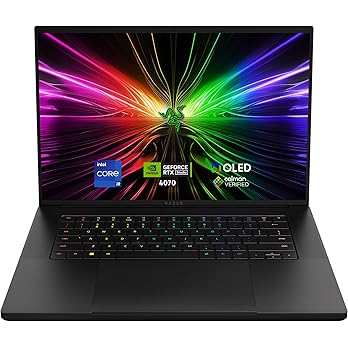When selecting a laptop for someone with poor eyesight, it’s essential to consider specific features that enhance screen visibility, reduce eye strain, and improve overall comfort. The best laptops for users with vision issues combine high-resolution displays, adjustable settings, and eye-friendly technologies. Here are some of the top factors and laptop models to consider:
Key Features to Look for:
- High-Resolution Display: A higher resolution, such as 4K (3840×2160), ensures sharper text and images, making it easier to read fine details without straining your eyes. A Full HD display (1920×1080) is also sufficient for general use.
- Large Screen Size: A larger screen (15 to 17 inches) provides more screen real estate, allowing for larger text and icons. This can be crucial for users who have difficulty seeing small details on smaller screens.
- Adjustable Brightness and Contrast: A laptop with good brightness and contrast settings helps you adjust the display to your comfort level. Look for laptops with at least 300 nits of brightness and strong contrast ratios.
- Blue Light Filtering: Laptops with blue light reduction features or settings, such as Night Mode or Low Blue Light Mode, can help reduce eye strain caused by prolonged screen use.
- Anti-Glare Screen: Anti-glare or matte screen coatings reduce reflections, which is helpful in bright environments, reducing the need for eye squinting.
- Accessibility Features: Many operating systems, including Windows and macOS, have built-in accessibility features like screen magnifiers, high-contrast modes, text enlargement, and voice narration for easier navigation.
Best Laptops for Poor Eyesight:
Here are some laptops that excel in providing an eye-friendly experience:
1. Apple MacBook Pro (16-inch, M2 or M1 Pro/Max)
- Display: The 16-inch MacBook Pro offers a high-resolution Retina display (3072×1920), which provides excellent clarity and detail. The Liquid Retina XDR display is also available, with a peak brightness of 1600 nits for sharp contrasts.
- Accessibility Features: macOS includes powerful accessibility features like Zoom (screen magnification), VoiceOver, and high-contrast modes.
- Other Features: The True Tone technology adjusts the screen’s color temperature based on ambient light, reducing blue light exposure. The large screen and high resolution make text clearer and more readable.
Pros: Stunning display, large screen, extensive accessibility options. Cons: Expensive, limited port options.
2. Dell XPS 17 (9710 or newer)
- Display: This model has a 17-inch 4K Ultra HD+ display (3840×2400), offering crystal-clear visuals with excellent detail. It also includes InfinityEdge for nearly bezel-free viewing.
- Brightness: The XPS 17 offers a peak brightness of 500 nits, ensuring clear visibility in bright conditions.
- Accessibility Features: Windows 11 supports several vision-friendly features such as magnifiers, high-contrast themes, and text resizing.
Pros: 17-inch 4K display, high brightness, thin and portable despite its size. Cons: High cost, battery life can be shorter with the 4K display.
3. Microsoft Surface Laptop Studio
- Display: With a 14.4-inch PixelSense Flow display (2400×1600 resolution) and a 120Hz refresh rate, the Surface Laptop Studio provides smooth scrolling and sharp visuals. It supports vibrant colors and high brightness.
- Touchscreen: The laptop’s touchscreen feature allows users to zoom in on text or images easily.
- Accessibility: Windows’ built-in magnifier and other tools are complemented by the Surface’s ergonomic design.
Pros: High-quality touchscreen, high refresh rate, great accessibility options. Cons: Expensive, not as large a screen as others.
4. Lenovo ThinkPad X1 Yoga (6th Gen)
- Display: The ThinkPad X1 Yoga offers a 14-inch 4K OLED display, which is sharp, vibrant, and easier on the eyes with deeper blacks and richer contrast.
- Brightness: It has around 500 nits of brightness, suitable for most lighting conditions.
- Other Features: An anti-glare screen and wide viewing angles make this a comfortable laptop for long hours of use. Lenovo’s ThinkPads are also known for their robust build and ergonomic keyboards.
Pros: 4K OLED display, strong brightness, good durability. Cons: Pricey for a 14-inch model.
5. Acer Swift 3
- Display: This affordable model comes with a 14-inch Full HD display, which is sharp enough for everyday use. Though not 4K, its 1080p resolution is often sufficient for moderate vision issues.
- Lightweight: For those who need a more portable option, the Swift 3 offers a balance between screen size and portability.
- Accessibility: Windows 11’s built-in accessibility tools can make this budget-friendly laptop a good choice for users with vision challenges.
Pros: Affordable, lightweight, good battery life. Cons: Not as sharp or bright as premium models.
Honorable Mention:
- HP Spectre x360 (14-inch): This convertible laptop offers a great OLED display option, with stunning clarity and vivid colors that make it a great choice for users with poor eyesight. The touchscreen functionality and 2-in-1 design allow for flexible viewing angles and zooming.
Tips for Improving Laptop Use with Poor Eyesight:
- Increase Text Size: In both Windows and macOS, you can adjust the size of text, apps, and other on-screen elements to make them easier to see.
- Screen Magnification: Both Windows Magnifier and macOS Zoom can magnify specific parts of the screen for closer inspection.
- Reduce Blue Light: Use built-in features like Night Shift on macOS or Night Light on Windows to filter blue light and reduce eye strain during long periods of use.
- Use Dark Mode: Dark Mode in both Windows and macOS can be easier on the eyes, especially for users who experience light sensitivity.
Conclusion:
For those with poor eyesight, the Apple MacBook Pro (16-inch) and Dell XPS 17 stand out as the top choices due to their high-resolution displays, large screens, and robust accessibility features. However, more budget-friendly options like the Acer Swift 3 also provide adequate comfort for users who need basic vision support without breaking the bank. Always prioritize screen resolution, brightness, and the availability of accessibility features when choosing a laptop for poor eyesight.





